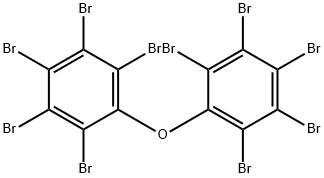1163-19-5

Product Name:
Decabromodiphenyl oxide
Formula:
C12Br10O
Synonyms:
Decabromodiphenyl ether solution;Decabromodiphenyl oxide
Inquiry
CHEMICAL AND PHYSICAL PROPERTIES
| Physical Description | Decabromodiphenyl oxide is a white to off-white powder with a chemical odor. (NTP, 1992) |
|---|---|
| Color/Form | Yellow prisms from toluene |
| Odor | Odorless |
| Boiling Point | Decomposes at 425 °C |
| Melting Point | 569.1 to 576.5 °F (NTP, 1992) |
| Solubility | less than 1 mg/mL at 68 °F (NTP, 1992) |
| Density | 3 (NTP, 1992) - Denser than water; will sink |
| Vapor Pressure | less than 1 mmHg at 68 °F (NTP, 1992) |
| LogP | log Kow = 9.97 /HPLC method/ |
| Stability/Shelf Life | Stable under recommended storage conditions. |
| Decomposition | When heated to decomposition it emits toxic fumes of /hydrogen bromide/. |
| Collision Cross Section | 204.5 Ų [M-Br+O]- |
| Other Experimental Properties | 83% bromine content /commercial product/ |
| Chemical Classes | Other Classes -> Halogenated Polyaromatics |
SAFETY INFORMATION
| Signal word | Danger |
|---|---|
| Pictogram(s) |
 Flame Flammables GHS02  Corrosion Corrosives GHS05  Exclamation Mark Irritant GHS07  Health Hazard GHS08  Environment GHS09 |
| GHS Hazard Statements |
H225:Flammable liquids H302:Acute toxicity,oral H304:Aspiration hazard H312:Acute toxicity,dermal H315:Skin corrosion/irritation H318:Serious eye damage/eye irritation H320:Serious eye damage/eye irritation H336:Specific target organ toxicity,single exposure; Narcotic effects H341:Germ cell mutagenicity H351:Carcinogenicity H373:Specific target organ toxicity, repeated exposure H410:Hazardous to the aquatic environment, long-term hazard H413:Hazardous to the aquatic environment, long-term hazard |
| Precautionary Statement Codes |
P201:Obtain special instructions before use. P202:Do not handle until all safety precautions have been read and understood. P210:Keep away from heat/sparks/open flames/hot surfaces. — No smoking. P260:Do not breathe dust/fume/gas/mist/vapours/spray. P264:Wash hands thoroughly after handling. P264:Wash skin thouroughly after handling. P273:Avoid release to the environment. P280:Wear protective gloves/protective clothing/eye protection/face protection. P331:Do NOT induce vomiting. P301+P310:IF SWALLOWED: Immediately call a POISON CENTER or doctor/physician. P305+P351+P338:IF IN EYES: Rinse cautiously with water for several minutes. Remove contact lenses, if present and easy to do. Continuerinsing. P308+P313:IF exposed or concerned: Get medical advice/attention. P370+P378:In case of fire: Use … for extinction. P405:Store locked up. P501:Dispose of contents/container to..… |
COMPUTED DESCRIPTORS
| Molecular Weight | 959.2 g/mol |
|---|---|
| XLogP3 | 10.4 |
| Hydrogen Bond Donor Count | 0 |
| Hydrogen Bond Acceptor Count | 1 |
| Rotatable Bond Count | 2 |
| Exact Mass | 959.16804 g/mol |
| Monoisotopic Mass | 949.1783 g/mol |
| Topological Polar Surface Area | 9.2 Ų |
| Heavy Atom Count | 23 |
| Formal Charge | 0 |
| Complexity | 345 |
| Isotope Atom Count | 0 |
| Defined Atom Stereocenter Count | 0 |
| Undefined Atom Stereocenter Count | 0 |
| Defined Bond Stereocenter Count | 0 |
| Undefined Bond Stereocenter Count | 0 |
| Covalently-Bonded Unit Count | 1 |
| Compound Is Canonicalized | Yes |
PRODUCT INTRODUCTION
description
Decabromodiphenyl oxide is a white to off-white powder with a chemical odor. (NTP, 1992)
